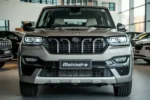There is set to be a significant shift in India’s transportation patterns These days, I guess the greatest thing that has happened is to be announced by Patanjali the wellness company started by Baba Ramdev. For they just priced a bike at ₹5,000 for electric and makes it travel 80 kms on a single charge!
In India, there is going to be a big change in the transportation pattern of recent There, I guess the most important thing to happened today is that Patanjali the wellness company founded by Baba Ramdev announced. For the debenture likes to have priced a bike at ₹5,000 but states that it will run 80 kms on single charge!
The Big Announcement
In Haridwar last week Baba Ramdev announced to a full house: Transportation must be as available as to basic nutrition. The motivation to do this, he said, is what spawned Patanjali into the electric mobility with the same move theymade did — making essential items for the masses accessible and affordable.
Specifications: The announcement with Figures that could match products costing five times less Most notably, Patanjali claims 80 kms on a single lift of an electric cycle with a 250W brushless DC motor.
The cycle features handy tools like an LCD for speed and battery info, a USB for charging phones, and straps on the handlebars you can tighten.
Also the battery does not last forever so it can be operated as traditional bicycle, thus never stranded riding.
How Patanjali got ₹5,000 product: The Price point
Probably the most surprising thing about this launch is its starting price. And to give you an idea, electric cycles in India begin from ₹20,000 and go up as high as around ₹80,000 for premium variants. Then, how did Patanjali get its price tag down to just Rs 5K?
As per Acharya Balkrishna, Patanjali’s Managing Director, they achieved this by a number of innovative ways:
- Direct sales approach: Then they have eliminated the middlemen passing by manufacturing in their factory at Haridwar &direct sourcing the product for Patanjali stores across country.
- Indigenously Made: 95 per cent of components are locally made and worked with the smaller manufacturers in Uttarakhand and western Uttar Pradesh.
- Re-cycled Battery technology : The battery is made on the recycled, repurposed cells from the bigger battery pack and offers significant cost reduction while serviceability is assured via stringent regulations.
- Very Low Profit margins: Patanjali is running this first production of 100,000 with margins the least because it kind of treating this as a social initiative rather than an ordinary business.
80 KM Technology
What is remarkable about a claimed range of 80 kilometers looking at electric cycles that cost ₹30,000-40,000 and provide nothing more than a range of 40-60 km. Dr. Pradeep Sharma, the was chief project Engineer describes three major contributions that made it possible :
- Building with Less Weight: The frame employs an advanced aluminum alloy, saving a lot of weight without cutting into any structural strength.
- Better Motor Efficiency : High grade n.d magnet and dense copper wound in this high ratio motor yields ~15% efficiency gain.
- The smartest move they made was the novel power management system ramping power in real-time (on a terrain Vs rider input dependent basis) and managing battery state.Power distribution over time: See our rider patterns evolve to optimize power distribution for your every day routes
Compared to Other Transportation Methods (Cost comparison)
The economics are strong. A motorcycle will eventually run on ₹80,000 (~=$1,200 USD) and at that will cost as much, ₹3 a kilometer; the Patanjali electric bicycle you don’t even have to scrap ₹5,000 when its dead and ₹0.15/ KM driving- an overhaul of 95% on operating cost.

Environmental Impact
In India riding a two wheeler account for atleast approx 25 crores cyclists and any shift from petrol cycle would yield significant reduction in carbon emission. Most of the vehicle fleet in India exceeds 70% traditional petrol two-wheelers, emitting about 2.5 kg CO2 per 100 km.
For a typical domestic commuter who travels 2,000 km per year it equates to about 50 kgs of CO2 from petrol vehicle. And the cycles will be even more eco-friendly, as orders of this electric cycle are being reduced by around 40–60%this effectively means that it will also be even greener when India’s grid gets greener with more renewables.
Who Will Benefit Most?
The social aspect of this launch is going to be HUGE. Less than a months salary for most Indian states,INR 5k this electric cycle will allows those who have never considered the cost of motorised mobility.
Daily reduced commuting time for students to school and colleges Multiple jobs workers going to factories, building sites (immobilized by transit) will have job opportunities. Local market small vendors can now scale up the reach and efficiency.
Patanjali has also announced weekly installments of as low as ₹100, making it more affordable to all. The company will also provide ₹1,000 discount on conventional cycles that customers plan to trade in.
Challenges and Caution
There is excitement, but industry veterans are firing some key questions. Lower the cost, fewer doubts about quality. Rakesh Sharma (senior automotive analyst) — “You can no more afford quality electric mobility at the cost of ₹5,000 without compromising something essential.
FileSynclah udhakother concern are
- Production Capacity: Patanjali lacks manufacturing infrastructure to produce 100,000 units and it has not produced much in the way of electromechanical manufacturing.
- After Sales : Still, need of idea around maintenance and support across India
- — Part 1 — Get The Parts That Last: If it costs less than you could get an aftermarket part for or it gets replaced frequently, that is expensive in the long run.
But some well-known EV makers are afraid that in case the low-cost products fall short, it will shake consumer confidence in electric mobility and slows down the process of EV adoption.
Future Plans
Patanjali Electric Cycle — not over here. They have laid out a pretty aggressive timeline for their mobility brand:
- Eco Scooter : Plan -> ₹40,000 price range within 18 months
- Non-passenger vehicle (NEV): a four wheel vehicle restricted to commercial use
- In-charging station service network — 500 service centers in India
- Battery Swapping: Coming to the future versions, they would have swapping batteries to reduce the charging time
Market Response
Big and fast from the market end. Orders already crossed the 50k pre-order mark within just a week of announcement, signifying substantial consumer interest. Such a kind of requirement meets the fact that Patanjali sensing a real requirement in market.
The relaunch has also pushed established brands to rethink their own plans. If even replicating half of what they are managing to accomplish, it would effect a huge move for the budget two-wheeler market in India with potential repercussions affecting other upcoming EV, as well.
The Bigger Picture
Part of the Product, but Beyond That – Patanjali’s electric cycle raises a question larger than an EV must be expensive because it runs on electricity.
They may have inadvertently sped up India, by proving that an electric sugg (cycle) can be cost effective.
This seemingly humble electric cycle might not be a mode of transport it could very well be the pathway towards a more sustainable and equal future for all, especially in a country wracked by air pollution, traffic jam and the staggering inequity of economics.
“I am so excited for the first time, technology is being developed for us people who don’t have so, we thought! one of the early testers a 45 year old vendor from Meerut.”
Final Thoughts
Whether Patanjali comes through with every promise it makes is still unknown. Quality, service and production capacity are legitimate questions which shall only be answered by time. Yet, the fallout of this announcement will transcend well beyond the confines of merchandise only
Patanjali has shown that tech is not alien, and can indeed be made affordable — at the least with electric mobility (₹5000+1500 kms). In the crowded world of innovation, this electric cycle is a powerful example of how true innovation is not ‘more’, but opening technology to everyone even if they earn less.
With Electric Cycle that goes for as low as ₹5000 and successful, the transportation revolution to millions of Indians on a cleaner more affordable mobility may commence — successful or not. That revolution, however may start with an ₹5,000 electric cycle in a country where even a rupee matters.



